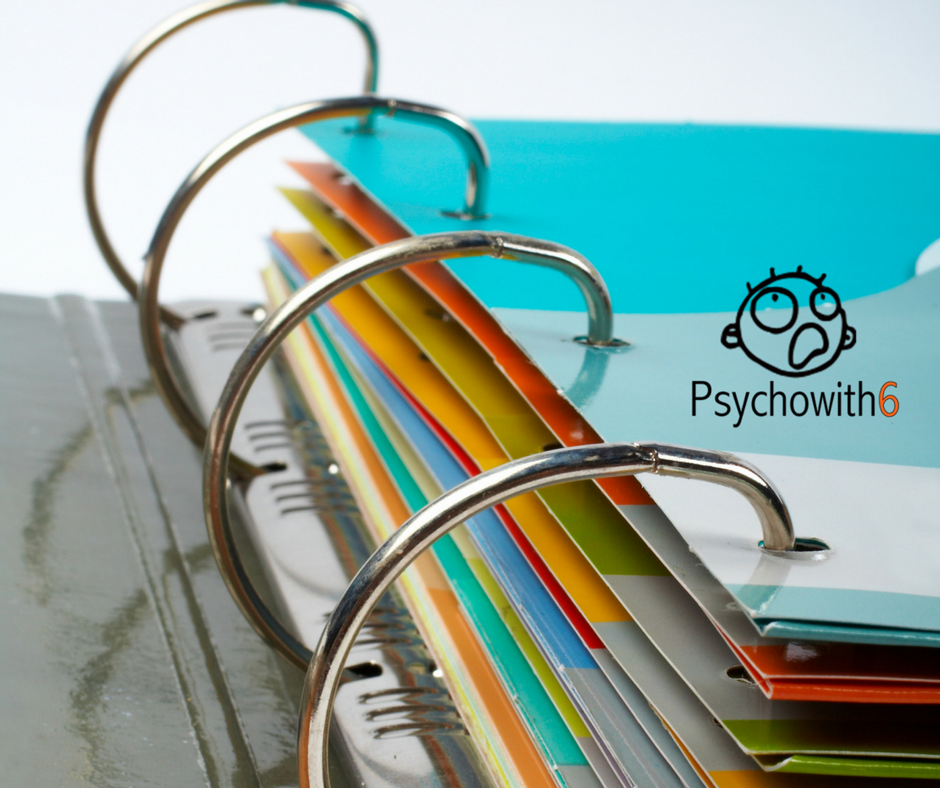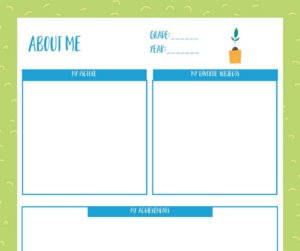
What is a homeschool portfolio and how can it save our sanity? Read on for inspiration.
First, what is a homeschool portfolio?
A homeschool portfolio, in short, is a record of what your child is learning. It might be a digital or print record, often kept in a binder.

It can include information about your child for that school year — height, weight, likes, dislikes, and friends, for example. A picture of your child is often a part of this page.
A homeschool portfolio can include goals for that student for the year. These could be academic goals like mastering multiplication facts, life skill goals like learning to do laundry, or social goals like learning to manage conflict with siblings. I did two episodes on that topic, by the way.
A homeschool portfolio can also include information about your child’s complete course of study: school schedule, subjects being learned, texts and outside classes being utilized, extra-curricular activities, books being read, and field trips taken. It is not, generally speaking, a lesson plan book with notes on which pages were completed on which days.
Finally, a homeschool portfolio can serve as an evaluative record. It’s a place for recording attendance, noting progress using tests or work samples, and adding end-of-term grades. It can be used for you and your student to assess how she is doing.
How a Homeschool Portfolio Can Save Your Sanity
That’s what a homeschool portfolio is. Now why do you need one?
The first reason you need a homeschool portfolio is to provide evidence of work completed if you are required to meet with an evaluator. The key information is all in one place for each student, keeping your anxiety about these evaluations to a minimum. Your organization in keeping a portfolio is likely to impress the educator you’re working with or at the very least will present no red flags.
But do you need a portfolio if you aren’t required to have evaluations? You might. Many states’ homeschool requirements can be fulfilled with a homeschool portfolio. Tracking attendance with number of school days and documenting your student’s course of study with work samples may be legally required. A portfolio is an excellent and easy way of meeting that requirement.
So what if you aren’t legally required to maintain a portfolio in your state? You still might want to keep one. The first reason is because you may need to present the information should your circumstances change. If your homeschooling would ever be called into question, your portfolio would go a long way toward documenting your work and protecting yourself and your kids. Should you decide to send your child to school at a later date, your portfolio can help a guidance counselor determine which courses would be most appropriate for your child and may even prevent your student from having to retake classes.
The second reason you may want to keep a homeschool portfolio, even if you aren’t required to, is so you can see your child’s progress. Homeschooling is a long-term project. There are so many days when you feel like you’re getting nowhere fast. Reviewing your goals for your child is likely to remind you that you have had significant accomplishments, even if your progress isn’t perfect. Your child may also feel like she isn’t improving. A record of work done at the beginning of the year and even from previous years will help her to see that she is moving forward.
Finally, you may want to keep a homeschool portfolio, even if you aren’t required to, for sentimental reasons. My husband has many papers from his elementary years and it is a joy for all of us to look at them. I use my kids’ portfolio when I put their school years’ scrapbooks together as well. Their artwork and written work can be scanned and added to either a print or digital scrapbook and will be enjoyed for decades.
How Do I Start Keeping a Homeschool Portfolio?
If I’ve convinced you to keep a homeschool portfolio, how can you start?
 First, choose a portfolio. This portfolio from Not Consumed is a great choice. Or print this free pack from Talking Mom 2 Mom.
First, choose a portfolio. This portfolio from Not Consumed is a great choice. Or print this free pack from Talking Mom 2 Mom.
The most common way of keeping a portfolio is to use a three-ring binder. Use your portfolio printables to organize your pages. The free download includes pages for dividing your binder by subject area. However, you could also set up your portfolio using hanging file folders. Each child could have a wide hanging file folder with smaller subfolders or his own crate with folders for each subject. Yet another way of creating a portfolio is digitally. Use a program like Dropbox or Google Drive to create a folder or set of subfolders for each child.
Whichever method you choose, set it up before the beginning of the school year. Get started on filling out your goals and curriculum choices for each student.
Then ask your child to complete information about himself when school begins. You could ask your child to add books to his books list as he reads them. You’ll mark attendance each day. Add any tests or evaluations done to your portfolio as soon as they are completed. You may wish to collect relevant work samples near the end of the term. I remove sample pages from the beginning, middle, and end of a child’s workbook, for example. At the end of the year, discuss progress on goals with your student and you and your child can note your thoughts in the portfolio.
Conclusion
The process of keeping a homeschool portfolio can be a rewarding one for you and your child, whether you are required to keep one or not. Choose a portfolio printable or digital approach and get started using your portfolio today.







